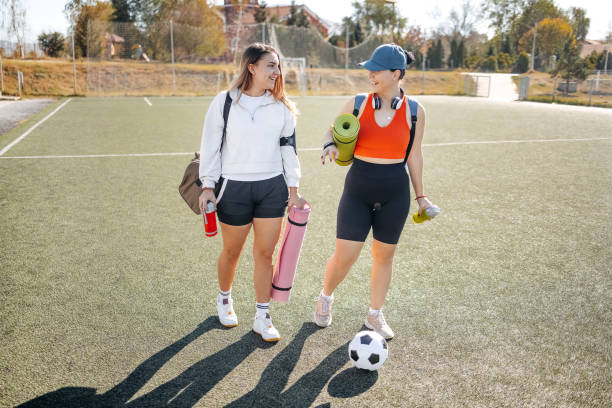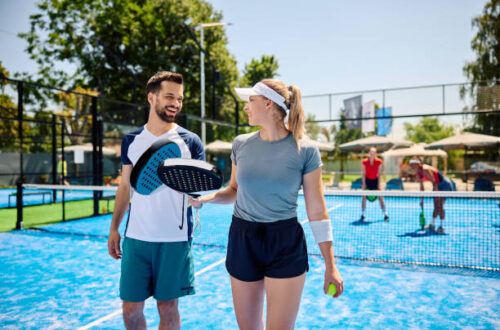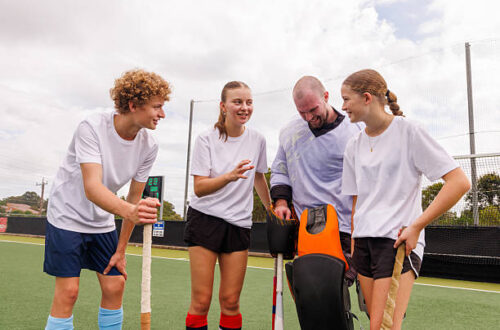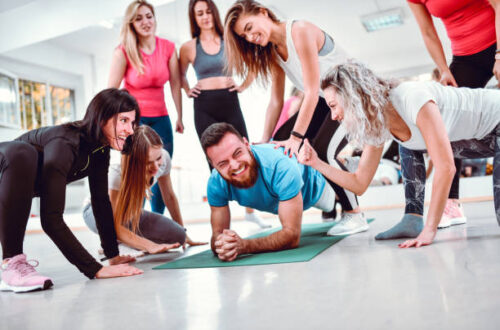Student life is a rollercoaster. There are late-night study sessions and exam stress. It’s all about balancing academics and social life. In all of this chaos, it’s easy to let your physical and mental health take a back seat. But what if there was one activity that could improve your grades, boost your mood, and help you stay fit, all at the same time?
The secret weapon for every student is sports.
Physical activity is not just about building muscle or losing weight. It is a powerful tool for sharpening your mind, reducing stress, and building life skills that will benefit you long after graduation. This blog post will look at the best sports for students. These activities can boost fitness and mental health. Plus, I’ll share tips to get started, even if you’re on a budget.
The Science Behind the Sweat: How Exercise Helps Your Brain
Contents
Before we dive into the list of sports, let’s understand why they are so crucial for a student’s well-being. The connection between your body and your brain is stronger than you think.
Boosting Brainpower and Focus
When you exercise, your heart rate increases, which boosts blood flow to your brain. This delivers more oxygen and nutrients, which can directly improve your cognitive functions. Physical activity boosts neurotransmitters like dopamine and serotonin. These are the “feel-good” chemicals that lift your mood and motivation. In essence, a good workout can make you feel more energized and focused when you sit down to study. This is why a quick walk or run can be a more effective study break than scrolling through your phone.
A Powerful Stress Reliever
Student life is filled with pressure, and sports offer a natural and healthy outlet for that stress. Exercise helps your body release stress hormones like cortisol, which can build up during times of high anxiety. The physical act of running, playing a game, or even stretching can help you to disconnect from your worries and be fully present in the moment. It’s a form of meditation in motion, helping you to clear your mind and return to your work feeling refreshed.
Building Life Skills
Sports teach you valuable lessons that go beyond the field. You learn teamwork, leadership, and communication in a real-world setting. You also build resilience—the ability to bounce back from a loss or a setback. These are all essential skills that will serve you well in any career path you choose.
Top Sports for Students: A Guide to Fitness and Fun
Here are some great sports for students. They are easy to access, good for mental health, and fit well into busy schedules.
1. Running and Jogging 🏃♀️
The Ultimate Student-Friendly Sport: Running is at the top of the list because it is the most accessible. All you need are a decent pair of running shoes and a desire to move. It’s a fantastic way to explore your campus, get fresh air, and enjoy some alone time. Running can be done at any pace, from a slow jog to an intense sprint, making it perfect for all fitness levels.
Mental Benefits: Running is a powerful tool for managing stress and anxiety. The steady motion and rhythmic breathing can feel calming. The “runner’s high” from endorphin release is a true mood lifter.
2. Swimming 🏊♂️
A Low-Impact, Full-Body Workout: If your campus has a pool, swimming is a fantastic, low-cost option. It targets all major muscle groups and is easy on your joints. This makes it ideal for injury recovery or for students with joint pain.
Mental Benefits: The water has a calming effect, making swimming a perfect way to de-stress after a long day of lectures. It’s a great way to unplug from the digital world and focus on the present moment, listening only to the sound of your own breathing.
3. Yoga 🧘
Connecting Mind and Body: While many people don’t think of yoga as a sport, its benefits for both physical and mental health are undeniable. All you need is a mat and a small space in your dorm room. Your campus recreation center may also offer free classes.
Mental Benefits: Yoga is a master class in mindfulness. It teaches you to control your breath, listen to your body, and calm your mind. This practice can greatly lower stress and boost your focus. Both are key skills for handling a busy academic life.
4. Basketball 🏀
Social, Fun, and High-Energy: A game of pickup basketball is a fun way to socialize and get an intense workout. Most colleges have free indoor and outdoor courts, and you only need a few friends to start a game.
Mental Benefits: Basketball is a great way to blow off steam and channel aggression into a healthy, competitive activity. Playing the game lets you make strong friendships and feel part of a community. This is key to battling loneliness and boosting happiness.
5. Hiking 🥾
Escape the Campus Bubble: Hiking is an amazing way to get a workout while exploring the natural beauty around you. It’s a low-cost activity that can be done solo for quiet reflection or in a group for social bonding.
Mental Benefits: Spending time in nature is scientifically proven to reduce stress and anxiety. Hiking offers a change of scenery and a break from the constant pressure of student life, which can refresh your mind and boost your creativity.
6. Martial Arts 🥋
Discipline and Self-Confidence: Many colleges offer clubs for martial arts such as Karate, Judo, or Taekwondo. These classes are perfect for beginners and offer a unique blend of physical and mental training.
Mental Benefits: Martial arts teach discipline, focus, and self-control. The consistent practice helps you build confidence in your body and your abilities. It’s also a powerful outlet for stress, helping you to channel your energy in a positive way.
7. Soccer (Football) ⚽
Teamwork and Endurance: Soccer is a universally loved sport that requires minimal equipment. A casual game can be a fantastic way to meet new people and get a great cardio workout.
Mental Benefits: As a team sport, soccer emphasizes communication and collaboration. The need to work together to achieve a common goal helps you build strong social bonds and teaches you how to be a supportive teammate.
8. Badminton 🏸
A Quick and Fun Workout: Badminton is a fast-paced game that’s perfect for a quick break between classes. It can be played indoors, so it’s a great option regardless of the weather.
Mental Benefits: The quick, dynamic nature of the game forces you to focus on the present moment, which can help you forget about the day’s worries. It’s a fun, low-pressure way to improve your reflexes and coordination.
9. Table Tennis (Ping-Pong) 🏓
Sharpening Your Reflexes: Don’t underestimate ping-pong. It’s an incredibly fast-paced game that requires quick thinking and sharp reflexes. It’s a great way to socialize and compete in a fun, casual setting.
Mental Benefits: Ping-pong is a fantastic way to improve your hand-eye coordination and mental alertness. The short, intense bursts of focus can help you train your brain to concentrate for longer periods of time, which is a great skill for studying.
10. Volleyball 🏐
Communication and Agility: Whether you’re playing indoors or on a sand court, volleyball is a very social and fun sport. It’s easy to learn and is a great way to meet new friends.
**Mental Benefits:** Volleyball is a team sport. It helps you build trust and a sense of community with your teammates. The constant communication and fast-paced action can help you release pent-up energy and stress in a healthy way.
11. Tennis 🎾
Strategy and Stamina: Many campuses have free tennis courts, making this a great option for a workout with a friend. It’s a fantastic way to improve your reflexes, coordination, and stamina, and it can be a highly strategic and engaging game.
**Mental Benefits:** Tennis demands sharp focus and quick problem-solving. You must react to your opponent and think ahead about your next shot. This can help you train your brain to think quickly and strategically under pressure, a skill that is very useful in an academic setting. It also provides a great mental outlet and a sense of accomplishment with every point you win.
12. Cycling 🚴
A Practical Workout: Cycling is not only a fantastic cardio workout but can also serve as your primary mode of transportation. It’s a great way to explore the area around campus and can save you money on bus fares.
Mental Benefits: The rhythmic motion of pedaling can be meditative and calming, helping you to clear your head and reduce anxiety. It also gives you a sense of independence and freedom, which can be very empowering.
The Unexpected Social Side of Sports
Sports not only boost your body and mind but also enhance your social life. They help you build a strong support network.
Finding Your Tribe and Combating Loneliness
College can be a lonely experience for many students. Joining an intramural team or a sports club is one of the easiest and most natural ways to find people with similar interests. You’ll have plenty to discuss. Winning and losing together can build strong connections. It’s a much more relaxed and authentic way to make friends than awkward social gatherings.
Building Communication and Trust
Team sports, in particular, teach you crucial communication skills. You learn to give and receive feedback, trust your teammates to do their part, and work together toward a common goal. These skills are essential for group projects in class and for building healthy relationships in your personal life. The trust you build on the field can easily transfer to a strong support system off the field.
The Power of Healthy Competition
Competition doesn’t have to be a negative thing. In student sports, you can push your limits and challenge yourself. It’s also a fun way to celebrate your team and your opponents’ achievements. This healthy rivalry can be a great motivator and teaches you how to be a good sport, whether you win or lose.
Maximizing Your Results: A Student’s Training Guide
Staying active is only part of the equation. To truly get the most out of your sports, you need to support your body with the right habits.
The Importance of a Warm-Up and Cool-Down
It’s tempting to jump right into a game, but a quick warm-up is crucial for preventing injuries. A 5-10 minute warm-up of light jogging or dynamic stretches gets your blood flowing and prepares your muscles for a workout. After your workout, a cool-down with some static stretching helps your muscles recover and can prevent soreness. It’s a simple habit that makes a big difference.
Fueling Your Body Right (Without Breaking the Bank)
You don’t need expensive supplements to fuel your workouts. As a student, affordable and simple nutrition is key.
- Pre-Workout: A small snack about an hour before your workout can give you the energy you need. Think of a piece of fruit like a banana, a handful of crackers, or some yogurt. These are cheap, easy to get, and provide the carbs your body needs for fuel.
- Post-Workout: Within an hour or two after your workout, eat a combination of protein and carbs to help your muscles recover. This could be a turkey sandwich, a bowl of oatmeal with some nuts, or a glass of chocolate milk.
Listening to Your Body and Avoiding Burnout
The most common mistake students make is overtraining. Your body needs time to rest and recover. Make sure you are getting enough sleep—at least 7-8 hours a night. If you feel tired, sore, or unmotivated, it may be a sign that you need a rest day. Pushing yourself too hard can lead to injury and mental burnout, which is the exact opposite of what you are trying to achieve.
Your First Step: Overcoming the Biggest Obstacle
We all know exercise is good for us. The real challenge is finding the motivation to start. It’s easy to say, “I’m too busy,” “I’m too tired,” or “I’ll do it tomorrow.” The biggest obstacle isn’t a lack of time; it’s the feeling that you have to be perfect.
Instead of thinking about a full hour at the gym, just put on your sneakers and walk out the door for 15 minutes. The goal isn’t to set a world record or have the perfect workout. The goal is to simply start. Taking one small, positive action creates a domino effect. That 15-minute walk can lead to a 30-minute jog a few days later, which can eventually lead to a regular sport you love. The key is to remember that consistency is more important than intensity. Even a little bit of activity is far better than none. Don’t wait for the perfect moment. The best time to start is right now.
Frequently Asked Questions
Q1: What are intramural sports?
Intramural sports are organized leagues or tournaments for students within a single university. They are perfect for students who want to play a sport without the high-pressure commitment of a varsity team.
Q2: Will playing sports hurt my grades?
On the contrary, studies show that physical activity can actually improve academic performance. Exercise helps you focus, reduces stress, and can even boost your memory, all of which can lead to better grades.
Q3: How do I get over my fear of not being good at a sport?
Everyone starts somewhere. Most student sports clubs and intramural leagues are open to all skill levels. The focus is on having fun, staying active, and building a community, not on being an expert.
Q4: Is it okay to work out alone?
Absolutely. Individual sports like running, swimming, and hiking are great for introverted students. They’re also ideal for days when you need some time alone. They provide a great opportunity for self-reflection and mental clarity.
Q5: What if I get injured?
If you get injured, the most important thing is to listen to your body and rest. Don’t try to “push through the pain.” Most college campuses have a student health center that can provide a diagnosis and treatment plan. You can also try a low-impact sport like swimming to stay active while you recover.
Q6: What’s the best time of day to work out for students?
Both morning and evening workouts have benefits. A morning workout can give you an energy boost and help you feel more focused for the day ahead. An evening workout is a great way to de-stress after classes and can even help you get a better night’s sleep. The best time is simply the time that works for you and your schedule.
Q7: How can I stay active in the winter or when the weather is bad?
Look for indoor options. Campus gyms often have basketball courts, volleyball courts, and table tennis tables. Swimming is also a great all-weather sport. You can also get a fantastic workout with bodyweight exercises in your dorm room or by following a free yoga or HIIT workout video online.





